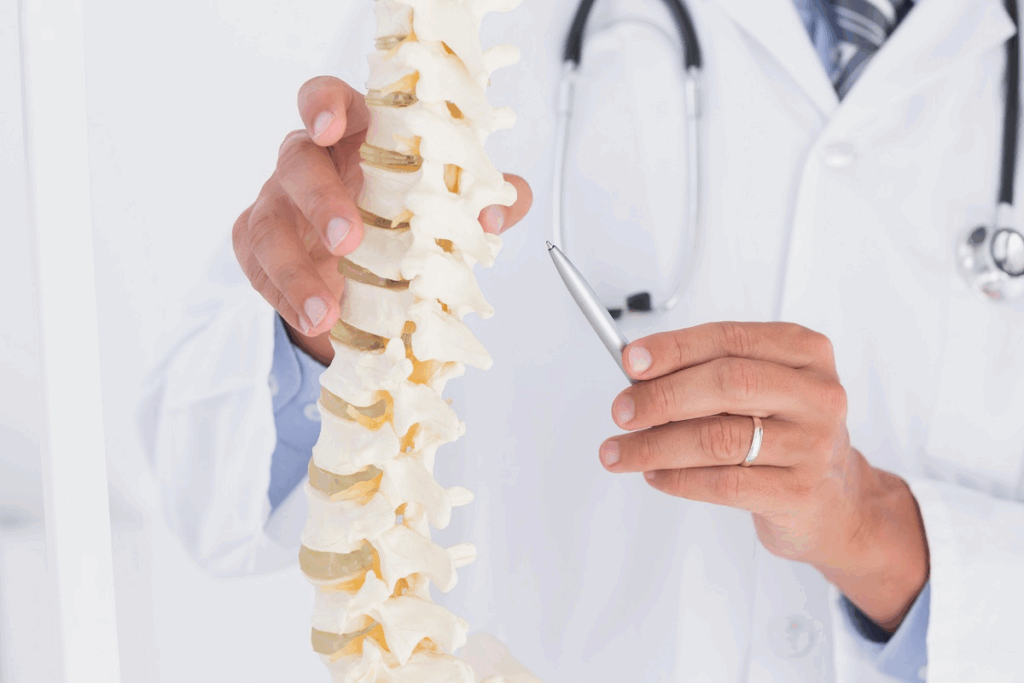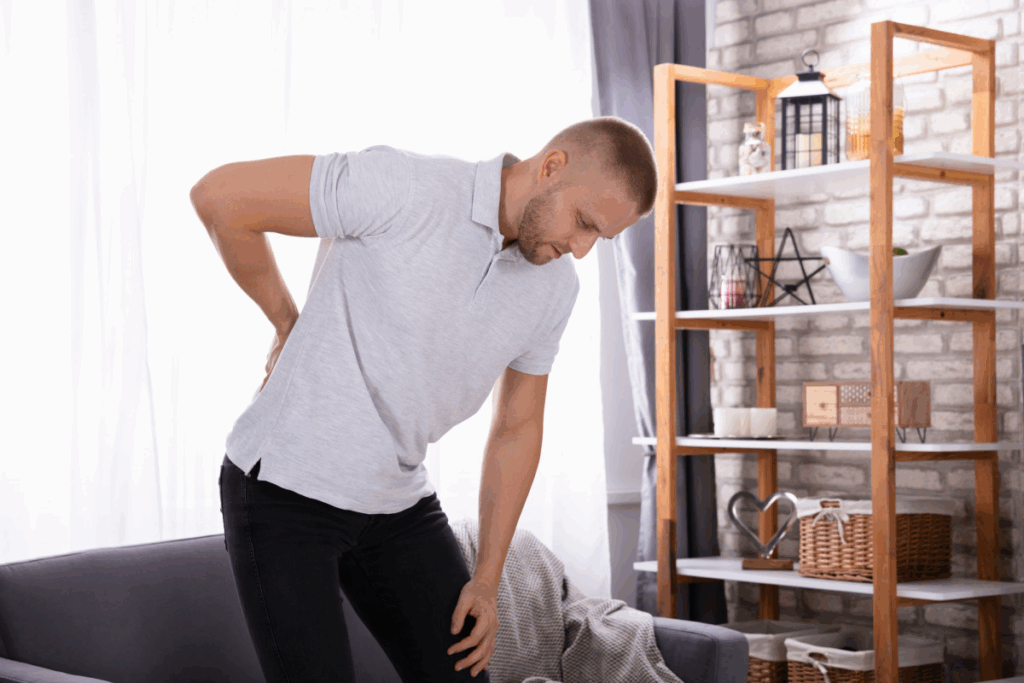Last Updated on November 4, 2025 by mcelik

Spinal stenosis affects millions of Americans, causing significant discomfort and impairment in daily life. This condition is characterized by the narrowing of the spinal canal. It leads to pain, numbness, and weakness in the legs. Find out how the best muscle relaxer for spinal stenosis can ease stiffness and nerve pressure.
Muscle relaxants are often prescribed to help manage the muscle spasms associated with spinal stenosis. By understanding how these medications work and their benefits, individuals can make informed decisions about their treatment options.
Spinal stenosis is a condition that affects the spine. It happens when the spinal canal narrows. This can put pressure on nerves and cause symptoms.
Spinal stenosis is a condition that affects the spine. It causes the spaces in the spinal canal to narrow. This can happen for many reasons, like aging or disc problems.
The condition can occur anywhere in the spine. But it’s most common in the lumbar region, like at the L4-L5 level. It’s also common in the cervical region.
There are many reasons why spinal stenosis happens. Some include:
These factors can make the spinal canal narrow. This can compress nerves. Symptoms include pain, numbness, and weakness in the legs or arms.
Symptoms can vary a lot from person to person. Knowing these symptoms is key to diagnosing and treating spinal stenosis.

It’s important to know how spinal stenosis impacts the body. This condition narrows the spinal canal. Symptoms vary based on where and how much it narrows.
Lumbar stenosis happens in the lower back. It can cause leg pain, numbness, and weakness. These issues get worse when standing or walking but may ease when sitting or leaning forward.
Common symptoms of lumbar stenosis include:
| Symptom | Description |
| Pain or cramping | Occurs in the legs, often due to nerve compression |
| Numbness or tingling | Can be felt in the legs or feet, indicating nerve damage |
| Weakness | Affects the legs or feet, making it difficult to stand or walk |
Cervical stenosis affects the neck. It can cause neck pain, numbness, and weakness in the arms or hands. In severe cases, it can make coordination and balance hard.
Symptoms of cervical stenosis may include:
Recognizing these symptoms is key to getting the right medical help. A doctor can diagnose and suggest treatments. This might include muscle relaxers for back pain relief.
Foraminal narrowing happens when the foramina, or nerve passageways, in the spine get smaller. This is closely tied to spinal stenosis. Both involve the compression or irritation of spinal nerves.
The foramina are small openings on either side of the spine. They let nerves exit the spinal canal. When these openings shrink, it can cause nerve compression. This leads to pain and discomfort.
Foraminal narrowing means the foramina get smaller. This can be due to degenerative changes, disc herniation, or spinal instability. The narrowing puts pressure on nerves, causing symptoms.
Causes of Foraminal Narrowing:
The symptoms of foraminal narrowing vary based on where and how much it narrows. Common symptoms include:
| Symptom | Description |
| Nerve pain | Sharp, shooting pain that radiates along the nerve pathway |
| Numbness or tingling | Sensations of numbness or tingling in the affected limb |
| Weakness | Muscle weakness in the affected area |
Knowing the symptoms and causes of foraminal narrowing is key to finding the right treatment. Sometimes, imaging studies like MRI or CT scans are needed to accurately diagnose it.
By recognizing the signs and symptoms of foraminal narrowing, healthcare providers can offer targeted treatments. These treatments help alleviate pain and improve quality of life for patients.

Muscle relaxers are key in managing spinal stenosis symptoms. This condition narrows the spinal canal, causing pain, numbness, and weakness. These medications help ease muscle spasms and pain.
Muscle relaxers reduce muscle tone and ease spasms. They work on the brain and spinal cord. This helps reduce discomfort and pain, making it easier to move and do physical therapy.
Doctors say muscle relaxants are great for acute musculoskeletal conditions. This is true for spinal stenosis patients, who often have muscle spasms.
Muscle relaxers offer big benefits for stenosis patients. They alleviate muscle spasms and pain, improving life quality. Key benefits include:
A study showed muscle relaxants improve outcomes with other treatments for spinal stenosis. This makes them a vital part of treatment plans.
Finding the best muscle relaxer for spinal stenosis means looking at different prescription and over-the-counter choices. Spinal stenosis narrows the spinal canal, leading to pain and discomfort. Muscle relaxers help manage these symptoms.
Prescription muscle relaxers help with muscle spasms from spinal stenosis. Cyclobenzaprine and tizanidine are two popular choices.
These prescription drugs can offer a lot of relief for spinal stenosis patients. But, they should only be taken as directed by a doctor because of possible side effects.
For those who don’t want prescription meds or want to add to their treatment, OTC muscle relaxers are an option. While not as strong as prescription drugs, some OTC options can help with muscle tension.
Natural supplements like magnesium and valerian root are sometimes used for muscle relaxation. But, their effectiveness can differ, and caution is advised.
People with spinal stenosis should talk to their doctor before trying any new medication, including OTC options. This ensures they are safe and right for their condition.
Cyclobenzaprine, also known as Flexeril, is a muscle relaxant often used for spinal stenosis. It blocks nerve impulses that send pain signals to the brain. This helps reduce muscle spasms and discomfort from spinal stenosis.
Cyclobenzaprine affects the central nervous system to relax muscles. It doesn’t directly relax muscles but changes nerve impulses. This reduces muscle spasms and helps with spinal stenosis pain and discomfort.
Key Benefits:
Cyclobenzaprine is effective for spinal stenosis but has side effects. Common ones include drowsiness, dry mouth, and dizziness. Rare but serious side effects include heart issues and severe allergic reactions.
| Common Side Effects | Less Common but Serious Side Effects |
| Drowsiness | Heart rhythm disturbances |
| Dry mouth | Severe allergic reactions |
| Dizziness | Mental/mood changes |
Before starting cyclobenzaprine, patients should talk to their healthcare provider. This ensures the treatment is safe and right for them.
In summary, cyclobenzaprine (Flexeril) is a good option for spinal stenosis symptoms. It helps with muscle spasms and pain. But, patients should know the side effects and work with their doctor to manage them.
Baclofen and tizanidine help with muscle spasms from spinal stenosis. But how do they stack up? These muscle relaxants work differently and have different side effects. It’s key to know these differences when picking a treatment for spinal stenosis.
Baclofen is a GABA receptor agonist, mainly affecting the spinal cord. It’s great for severe spasticity. Tizanidine, on the other hand, works by stimulating α2-adrenergic receptors. This action reduces muscle tone by stopping excitatory neurotransmitters from being released.
Because they work differently, baclofen and tizanidine might be better for different people. This depends on their condition and medical history.
Both baclofen and tizanidine can have side effects, but they’re not the same. Baclofen often causes drowsiness, dizziness, and weakness. Tizanidine is known for drowsiness, dry mouth, and low blood pressure.
Knowing these side effects is important. It helps manage what patients expect and ensures safe treatment.
In summary, baclofen and tizanidine are both good for treating spinal stenosis. But, their different ways of working and side effects mean the right choice depends on the patient’s needs and medical history.
Methocarbamol and carisoprodol are good choices for spinal stenosis pain relief. They work on the central nervous system to relax muscles.
Methocarbamol helps with muscle spasms without hurting muscle function much. It interrupts the pain-spasm cycle, helping those with spinal stenosis.
Carisoprodol is a muscle relaxant that works in the brain. It’s used with physical therapy to ease muscle spasm and pain.
Both drugs show promise in managing spinal stenosis pain. But, how well they work can differ for each person.
It’s key to think about the benefits and risks of methocarbamol and carisoprodol for spinal stenosis relief.
Patients need to be watched closely for side effects. The dose should be adjusted to lower risks.
Doctors should also look at the patient’s health history, including any substance abuse, before prescribing these drugs.
Managing nerve pain is key to treating spinal stenosis well. Nerve pain, or radicular pain, happens when nerves get compressed or irritated. This is common in spinal stenosis. Muscle relaxers are often used to help ease this pain.
Neuropathic pain in spinal stenosis comes from nerve compression or irritation. This compression sends pain signals to the brain, causing pain. Knowing how neuropathic pain works helps find the best treatments.
The pain can feel sharp, shooting, or burning. It often goes along the nerve’s path. In spinal stenosis, it usually hits the lower back or neck.
Muscle relaxers can ease muscle spasms that add to nerve pain. By loosening muscles, they help manage radicular pain from spinal stenosis.
Key benefits of using muscle relaxers for radicular pain include:
Even though muscle relaxers don’t directly treat neuropathic pain, they’re part of a full treatment plan. Always talk to a healthcare provider to find the best way to handle nerve pain from spinal stenosis.
Looking into natural ways to handle spinal stenosis is becoming more popular. People want to find holistic treatments to go along with traditional ones. Natural muscle relaxers are playing a big role in this search.
Herbal supplements are known for helping with spinal stenosis symptoms. Turmeric and ginger are famous for their ability to fight inflammation. This can lessen pain and discomfort.
Turmeric has a compound called curcumin, which is very good at fighting inflammation and protecting against damage. Ginger, too, has been shown to help with pain and swelling in studies. You can take these supplements in capsules, tea, or even add them to food.
There are also non-drug ways to manage spinal stenosis. Physical therapy is key, helping to move better, get stronger, and feel less pain. It includes stretching, strengthening, and aerobic exercises.
Mind-body therapies like yoga and meditation also help. They can reduce stress and improve overall health. Making healthy lifestyle choices, like keeping a good weight and standing right, can also help.
Using natural muscle relaxers and non-drug methods together can really help people with spinal stenosis. It can make a big difference in how they feel and live their lives.
NSAIDs are key in treating spinal stenosis. They help with pain relief and might avoid the need for more serious treatments. These drugs, or Nonsteroidal Anti-Inflammatory Drugs, are used to ease pain and lower inflammation. This is true for many conditions, including spinal stenosis.
NSAIDs fight stenosis pain by cutting down inflammation and easing pain. They block enzymes called COX-1 and COX-2. These enzymes help make prostaglandins, which cause inflammation and pain. By stopping prostaglandins, NSAIDs lessen the pain and swelling from spinal stenosis.
Benefits of NSAIDs for Spinal Stenosis:
Using NSAIDs with muscle relaxers can help manage spinal stenosis symptoms. NSAIDs tackle pain and swelling, while muscle relaxers ease muscle spasms. This mix offers full relief for those with both pain and muscle tightness from spinal stenosis.
| Treatment | Primary Benefit | Secondary Benefit |
| NSAIDs | Reduces inflammation and pain | May reduce need for invasive treatments |
| Muscle Relaxers | Relieves muscle spasms and tension | Enhances overall comfort and mobility |
| Combination Therapy | Comprehensive symptom relief | Potentially reduces medication dosage |
Before starting any new medicine, like NSAIDs or muscle relaxers, talk to your doctor. They can discuss possible side effects and find the best treatment for you.
Understanding L4-L5 stenosis is key to making good treatment plans. This condition narrows the spinal canal at the L4-L5 level. It can press on nerves and cause a lot of pain.
The L4-L5 area is more likely to get stenosis because it moves a lot and gets stressed. The narrowing can come from wear and tear, herniated discs, or unstable spines. This can lead to pain, numbness, or weakness in the legs.
Managing L4-L5 stenosis well means using specific treatments. These can include physical therapy to boost mobility and strength. Also, epidural steroid injections to cut down on swelling, and muscle relaxers to ease muscle tightness.
Conservative Management: First, treatments aim to be gentle. This includes physical therapy to make movements easier and stronger. It also includes epidural steroid injections to lessen swelling. And muscle relaxers to calm down muscle spasms.
Spinal stenosis, in its moderate to severe forms, needs a detailed treatment plan. It’s important to know how severe the stenosis is to choose the right treatment.
Doctors use a mix of clinical checks and imaging to see how bad the stenosis is. MRI and CT scans help show how narrow the spinal canal is.
They use a grading system to measure stenosis. This system helps decide the best treatment. It looks at how much the narrowing affects the nerves.
Treatment for spinal stenosis changes with its severity. For more serious cases, treatments might include both non-surgical and surgical options.
Muscle relaxers can help with symptoms of moderate to severe stenosis. They’re good for easing muscle spasms that make the condition worse.
| Treatment Option | Moderate Stenosis | Severe Stenosis |
| Muscle Relaxers | Often prescribed to manage muscle spasms | May be used in conjunction with other treatments to alleviate symptoms |
| Physical Therapy | Recommended to improve mobility and strength | May be limited due to pain and discomfort |
| Surgical Intervention | Rarely considered initially | Often considered when conservative treatments fail |
In conclusion, knowing the severity of spinal stenosis is key to picking the right treatment. Muscle relaxers can be a helpful part of treatment for moderate to severe stenosis. They help manage symptoms and improve life quality.
Muscle relaxers are key in a stenosis treatment plan. They help reduce pain and discomfort from spinal stenosis. Knowing the different options, like prescription meds and over-the-counter ones, helps people make better choices for their care.
Finding the best muscle relaxer for spinal stenosis depends on each person’s needs. Things like how bad the symptoms are, other health issues, and possible side effects matter. These factors help decide the right treatment.
Using muscle relaxers with other treatments like physical therapy and lifestyle changes can greatly improve life with spinal stenosis. It’s important to work with a healthcare provider to find the best treatment plan.
Spinal stenosis is a condition where the spinal canal narrows. This can press on the spinal cord and nerves. It causes pain, numbness, and weakness in the back, legs, and arms.
Spinal stenosis can be caused by several things. These include degenerative changes like osteoarthritis and disc degeneration. It can also be caused by congenital conditions, trauma, and spinal injuries.
Muscle relaxers help with muscle spasms, tension, and pain from spinal stenosis. They make it easier to manage the condition and improve life quality.
Foraminal narrowing is when the openings for nerves to exit the spinal canal get smaller. It often happens with spinal stenosis. This can cause more symptoms like radicular pain and numbness.
The best muscle relaxers for spinal stenosis include cyclobenzaprine, baclofen, tizanidine, methocarbamol, and carisoprodol. A healthcare professional can prescribe them to help manage symptoms.
Yes, NSAIDs can help manage spinal stenosis pain. They are often used with muscle relaxers to provide more relief.
Natural muscle relaxers, like herbal supplements, can help manage muscle tension and pain from spinal stenosis. They can be used with conventional treatments.
The severity of spinal stenosis is assessed through medical history, physical exam, and imaging studies. MRI or CT scans show the extent of narrowing and its impact on nerves.
Yes, muscle relaxers can help manage symptoms of moderate to severe spinal stenosis. They are part of a treatment plan that includes other therapies and interventions.
Yes, L4-L5 narrowing is a specific type of spinal stenosis. It can cause significant symptoms. Treatment approaches need to be tailored to address its unique characteristics.
Yes, muscle relaxers can help with nerve pain from spinal stenosis. They work best when used with other treatments, like NSAIDs and physical therapy.
Witenko, C. (2013). Considerations for the appropriate use of skeletal muscle relaxants. PMCID: PMC4103716. https://pmc.ncbi.nlm.nih.gov/articles/PMC4103716
Subscribe to our e-newsletter to stay informed about the latest innovations in the world of health and exclusive offers!
WhatsApp us